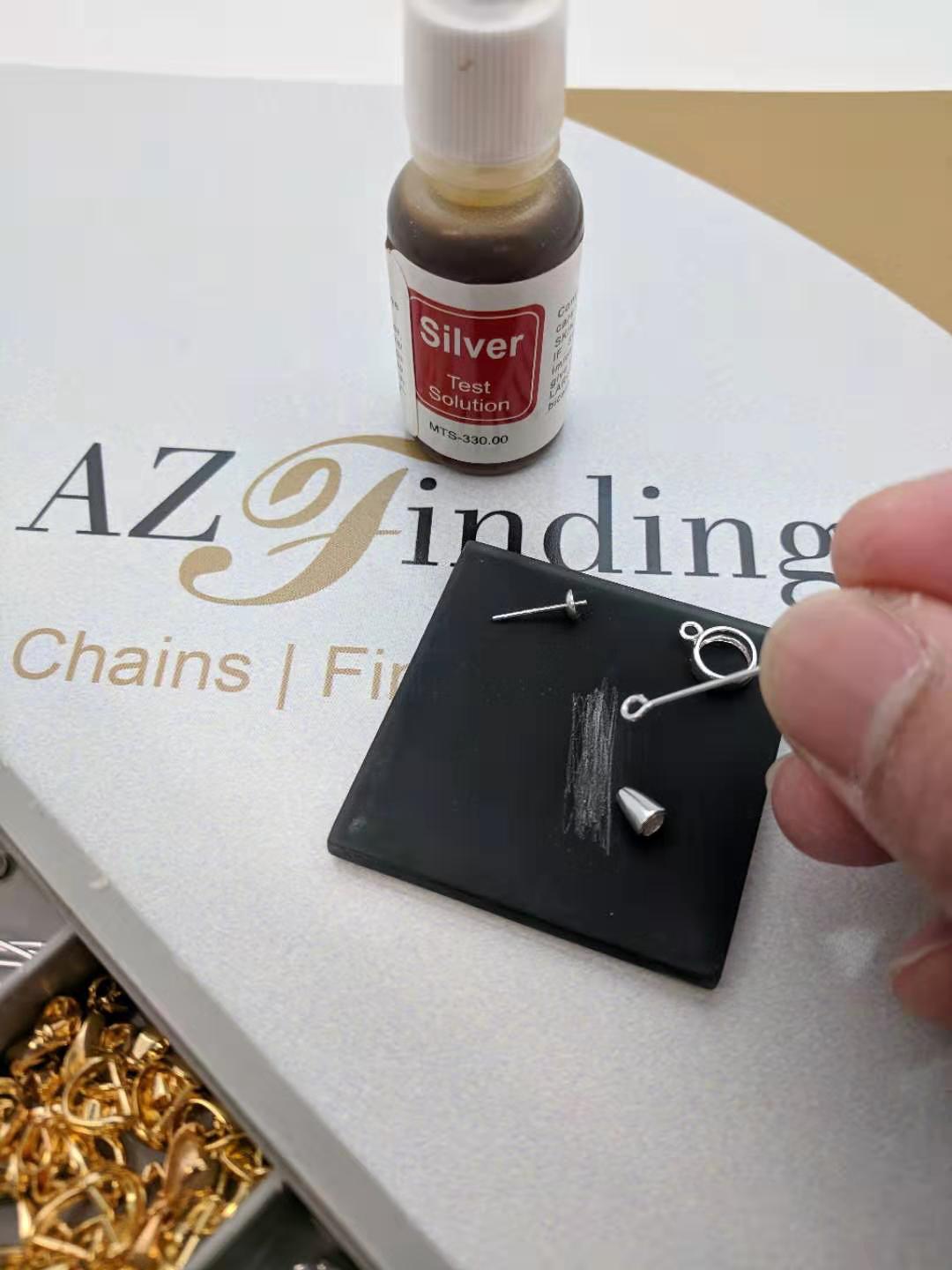
There are a lot of articles talking about how to test silver. Many techniques are only suitable for silver bars and silver coins. Testing silver jewelry or findings is unique. It is worth another article to cover this specific topic and share our years of experiences in trading and testing silver jewelry and findings with you.
- Stamping and marks on jewelry findings
Almost everyone knows to look for a 925 mark on the surface of your jewelry or findings. However, this method becomes tricky when it comes to jewelry chains and findings. Please note “925” mark is not on all authentic sterling silver pieces. For example, jewelry making bulk chains that are sold by the foot do not have the 925 mark. It’s just impossible or too expensive to stamp on every single link of the chain. Some small jewelry findings are not marked 925 as well. For example, jump rings don’t have 925 marks for the same reason as jewelry footage chain. When you place an OEM order with manufacturers for small silver findings, you can choose whether or not to stamp. Having that said, if you bought some silver jewelry findings that have no mark at all, don’t panic. It doesn’t mean it’s not real silver. You may just need to do further testing if you want to find out.
Be aware of other marks besides 925. For example, “925 FAS” mark could mean “Fused Alloy Silver”. That is not authentic sterling silver. Some other letter marks may be a brand name for your jewelry, don’t be confused. Ask your seller if you are not sure. Tibetan silver is not 925 silver, it only contains 30% silver. However, do not confuse Tibetan silver with Thai silver. Thai silver is sterling silver or could contain even more than 92.5% silver. “ALPACA” mark is for Alpaca silver or Alpaca Mexico silver. It is not sterling silver either. The same can be said for German silver.
- Magnetic test on jewelry findings
This works for most silver jewelry findings. However, it has some limitations that you need to be aware of. Do not use this method for certain findings like clasps. In order to let clasps function, some non-silver parts are needed, like the spring, which cannot be made of pure silver. As a result, many clasps will react to a magnet. Just run magnetic testing on the part that should only contain silver. For example, chain links, jump rings, blanks, etc.
Certain rhodium plated findings may have a very weak magnetic reaction. Rhodium does not stick readily to silver. In order to stick them together, a thin layer of other metal will be used. That may cause weak magnetic reaction. Please be aware of this when you test your rhodium plated pieces.
- Oxidize test on jewelry findings
Put a droplet of bleach or oxidize solution on silver to test its authenticity. If it turns a dark color, then it is silver. This method works well for silver jewelry or findings without any plating. However, many of today’s silver jewelry pieces have anti-tarnish plating or other kinds of plating on top of silver, so only applying the oxidizing test on the surface may not be enough. Don’t panic though if your silver item cannot be oxidized. Scratch the surface with filling at least half way down, and then do the oxidizing test on the exposed rough silver part. With the surface removed, you can then tell if your piece is solid silver or if it just has silver plating.
You can purchase acid testing kits online around $10. It comes with acid solution and a testing stone. Follow the instruction that comes with the kit. Sterling silver should turn into dark red color. Brown is for 80-90% silver. Green is for 65-75%.
Same as in oxidize test, make sure remove the surface plating layer when doing the acid test.
- What tests do not work for jewelry findings?
There is mention to many other silver testing methods on the internet. For example, Ice Test, Sliding Test, Ring (sound) test, Density test. They are more suitable for testing bigger and heavier silver objects, such as silver bars and silver coins. They do not normally work well for small jewelry findings.
What about sophisticated XRF and Electronic tests?
If you have a questionable silver piece that you don’t want to apply any intrusive testing, you can consider an XRF (X-Ray Fluorescence) test or Ultrasonic electronic test. However, as a jewelry trader for many years, I do not normally recommend this test for jewelry findings. Both electronic and XRF test will cost you money and are not 100% reliable when you don’t want to break the silver object apart. Check out this Youtube video (https://www.youtube.com/watch?v=89ATeNy3DIo) and see how a fake silver bar passed XRF test. Please note even the Ultrasonic machine used in that video can be fooled too. Most of the silver findings are not very expensive, it is better off to do an intrusive but cheap oxidize or acid test mentioned above.
As an importer and distributor, we routinely test our silver products. The same test techniques we use can also be used by most jewelry designers, sellers, or buyers. Out of all the testing methods we mentioned above, we recommend the oxidizing and acid tests. Always purchase from companies with a good reputation too. AZ Findings only sources silver jewelry chains and findings from the best manufacturers in the Industry. We only find new manufactures from the best industry trade shows to ensure our product quality and give ourselves, and our customers, a peace of mind. I hope this article is helpful to you. Leave a comment if you have any questions or call us at 1-888-500-1586.
